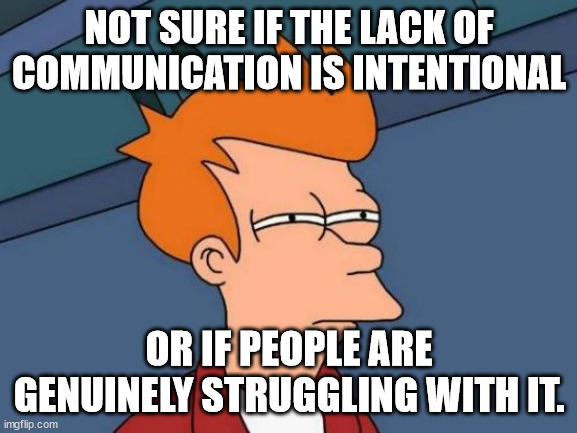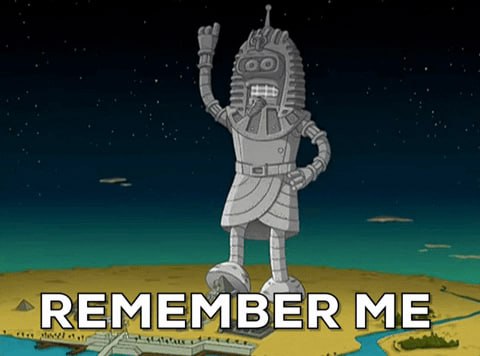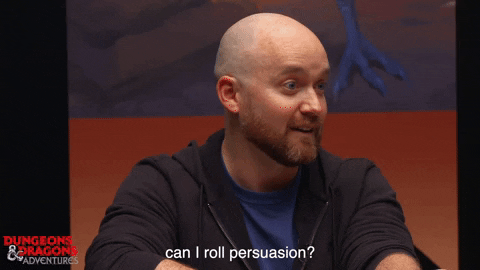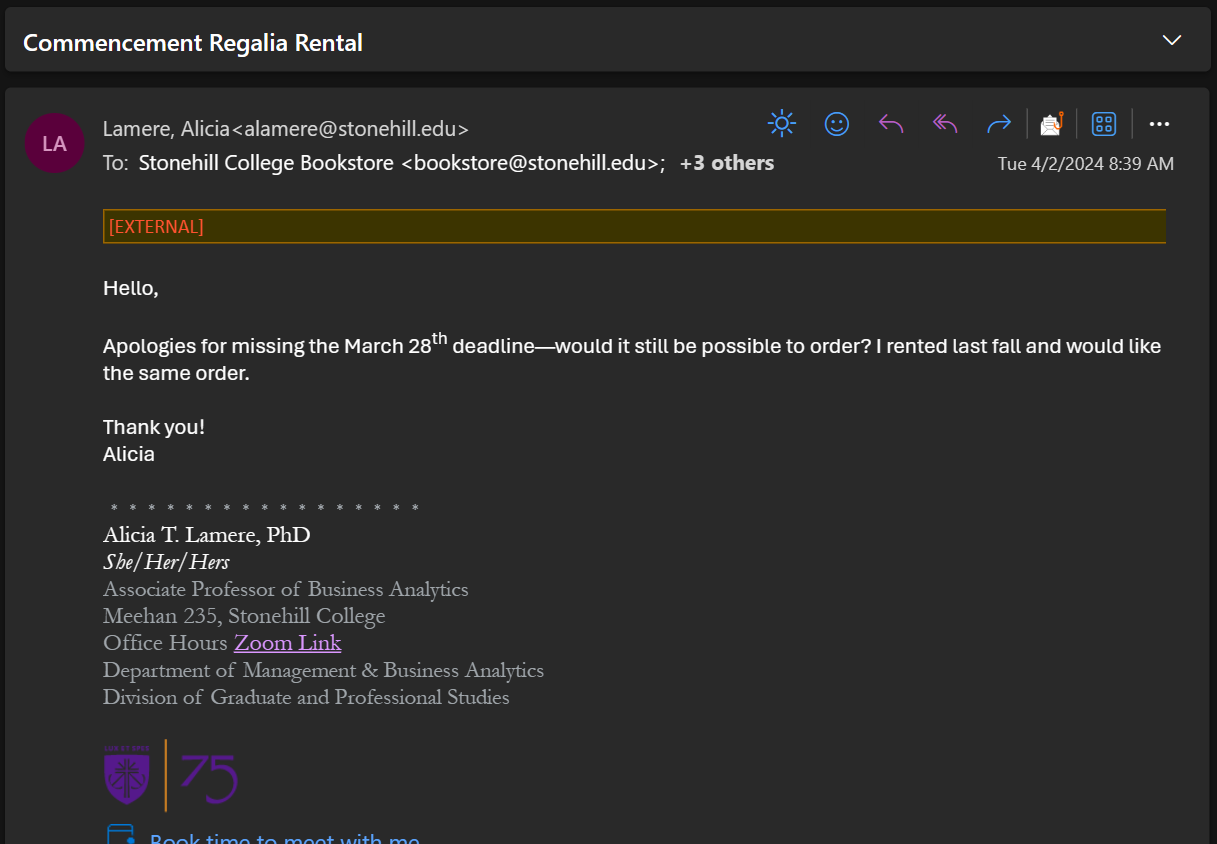12 Written and Verbal Communication

Our first lesson on professional non-technical skills focuses on written and verbal communication. This is one of the hardest professional skills to learn and master. Even those who have been in their professions for many years that require extensive verbal and written communication often struggle with it.
As a valuable resource, I strongly suggest reading “Great on the Job” by Jodi Glickman (Glickman 2011). This book offers excellent insights on improving workplace communication, which I’ve personally found beneficial in my professional interactions.
Many of the tips on this page come from insights gained from the book, my own experiences, and advice received from other professionals.
All examples provided in these callout boxes are written and verbal examples from within the past year (since 2023), with most from this year (2024). Although there is no sensitive information in the emails, I change the names, titles, organizations, etc.
12.1 Hello. My name is Inigo Montoya…
This is a popular meme, and one I like a lot, that covers all the essential aspects when reaching out to someone for the first time or after a prolonged period.

- Be polite
- Provide your name
- State your relationship
- Manage expectations
Similarly in Glickman (2011), the “hello” is three parts:
- Introduction
- Purpose of your call or email
- Key question
I will focus on this structure from Glickman (2011).
12.1.1 Introduction
The general idea here is to avoid assuming that everyone knows who you are, your affiliation with a school or company, or how you were connected to them.
I took a similar approach in our initial email exchange for this course. Given my role as an adjunct professor rather than full-time faculty at Stonehill College, I’ve provided a more detailed introduction to offer some background.
Dear Students,
I am Claire Bowen, your instructor for DAN 607: Security, Privacy, and Ethics. I am a senior fellow and lead the Data Governance and Privacy Team at the Urban Institute; a non-profit, non-partisan, public policy research institute HQed in Washington DC. However, I am a remote worker in Santa Fe, NM. My research focuses on developing technical and policy solutions aimed at safely expanding access to confidential data for advancing evidence-based policy-making. If interested, you can learn more here.
[removed rest of the email to focus on the introduction]
This next example is how a colleague introduced himself to me. Even though he worked at Urban at the same time I did, several months had passed, and we never worked on a project together. He didn’t presume that I remembered him and made sure to clearly state who he is and our prior connection.
Hi Claire,
This is Eric Smith – a former colleague from Urban. I’m currently on detail to the Treasury Department, where I sit on the racial equity team here supporting on efforts related to research and data. A big part of my role is engaging with the Office of Tax Policy on efforts related to equity and tax administration.
[removed the middle part of the email to focus on the introduction]
I can share more once we find a time to talk. Would you have time to chat this week? Sooner would be preferable if that works.
Thanks,
Eric
Here’s another example, this time introducing two individuals I know to each other. I’ve embedded links to help them learn more about each and their work as well as relevant references.
Good morning Jon,
I hope you’re doing well.
I would like to introduce you to Naomi Goldberg, the incoming Executive Director of the Movement Advancement Project. She recently saw the latest Do No Harm Guide on Collecting, Analyzing, and Report Gender and Sexual Orientation Data and wanted to connect with the people behind the report.
Naomi, this is Jon Schwabish, senior fellow in the Income and Benefits Policy Center at the Urban Institute. He is the mastermind on the Do No Harm Guide project, a series of guides on how researchers and practitioners can better approach their work with a DEI lens.
Please let me know if you need anything else.
Claire
Please note that I didn’t spell out “DEI” because I assumed both individuals, given their line of work, were familiar with the term. However, it’s generally advisable not to make this assumption unless you’re almost certain!
Also, I kept their names since I link to their profiles and their bodies of work.
12.1.2 Purpose
Next, it’s crucial to clearly state the purpose of the conversation. This should follow immediately after the introduction and should be concise, ideally in one or two sentences. The goal of any verbal and written communication is to ensure clarity within the first three sentences, as most people are busy and tend to skim emails or only listen for the first 15 seconds. This approach helps the recipient prioritize their responses, especially in cases where they receive a high volume of emails, such as myself, who typically receives around 50 emails a day.
In this next example, I’m reaching out to colleagues at a state office following a training session on data privacy techniques, specifically synthetic data generation. Given our recent communications, I skipped reintroducing myself and proceed directly to the purpose of this email after a brief greeting.
Good morning everyone,
I hope you are doing well and had a wonderful weekend.
The Urban team is reaching out to discuss scheduling office hours or support sessions to aid the state staff in implementing the required modifications to the tidysynthesis and syntheval code for generating synthetic data.
Please let us know of your preferred start time for these sessions, their frequency, and any additional support you may need.
We look forward to continuing to work with you.
Claire
12.1.3 Key question
Make sure to have the specific ask or key question in the verbal or written exchange, such as:
- Do you have a few minutes to talk about kicking off the project?
- Is this a good time to talk about the updates to the performance management process?
- Could you send the document that we discussed at in our check-in meeting last week?
- I am trying to reach Mike in Accounting. Do you have his contact information?
In the previous example, my key question is what is the preferred start time for the “office hours” or “support sessions” to aid the state staff members.
This next example is an email from someone asking me to write a letter of recommendation.
Dear Claire,
I am working to submit a nomination for Emilee Allen for the ASA mentoring award; see https://www.amstat.org/your-career/awards/asa-mentoring-award. Emilee identified you as someone who could speak to her mentoring impact on your career, so I was hoping to get your help.
If you could either:
- Provide me with a few sentences on the impact of Emilee’s mentoring on your career. If any of that interaction was in the early part of your career, please stress those points (per the ASA announcement). OR
- Write a letter of support – which can be no more than 2 pages – to include in the submission.
If you are willing to write a letter I can pull from that to write the overall nomination.
I know you are extremely busy, so I would be very appreciative of any information you can provide.
The nomination package is due March 1st, but I am hoping to have all information assembled by February 1.
Please hit reply all to this email as I am CCing my new email at the University at Buffalo (where I will start as Chair of Biostatistics in February).
Thank you for considering.
Best,
Daniel
12.1.4 Make requests into questions
In addition to Glickman (2011)’s structure, frame your requests into questions. Often our first emails to someone new are because we need to ask them something. This is already hard for verbal communication let alone written communication, where tone is hard to convey. If you have a request for someone, rephrase it like a question. It will sound more like the intent (a request) rather than a demand.
The email follows the recommended structure, but the tone is off because the request sounds like a demand. Additionally, Jeff and Brandon, who weren’t at the meeting, were CCed in the original email. If the request is phrased as a question and a comment is made about the CCed individuals, the tone will come across much lighter.

Hi Steve,
I’m Karen, a program manager for the project. Per our meeting on Tuesday, I need to finalize the project’s budget and have a deadline to get completed by 5/20. Would it be possible for you to get me your team’s FTE by 5/12?
I’ve cced Jeff and Brandon for their awareness since I need their rates too.
Karen
12.2 How to say “goodbye”
For most hello or introduction written and verbal communication, you want to have “next steps”, “action items”, or some sort of “forward momentum” (as Glickman (2011) refers to it). After you achieve your goal of your initial communication (was it a follow-up conversation or completing a task), you should keep the door open in some way.
The goodbye should include these two parts.
- Thank you
- Forward momentum
12.2.1 Always thank people for their time
Even if the conversation or interaction wasn’t productive or had the desired outcome, it’s always important to express gratitude for people’s time and effort. Being polite can go a long way. Also, people loved being thanked!

The following is an email from a colleague who had asked me about how to explain a privacy concept, differential privacy, at a high level for a presentation. Below is his response after I took the time to provide him with a high-level conceptual example. Notice that he thanked me several times throughout the email, which I bold.
Thanks Claire:
Great insight, very helpful. It’s an interesting exercise that helps me better understand what’s going on. The strategic spending of privacy bucks suggest some design/strategy ideas (giving away my operations research degree)…in some settings, it might be worth asking the same question a few times to get a sense of variability (with a cap on the number of questions, you might not be able to ask enough times to get a good estimate of the variance, but you might gain insight on the potential magnitude to some order…).
Thanks for the thoughts on this, I’m going to the Federal Cmt on Stat Methods next week and am summarizing some of our work…there are other talks in my session on DP, specifically, but I wanted to have an intuition-building statement before jumping to results. This was great. I’ll keep thinking about it and feel free to send any further thoughts. You do a really nice job of explaining these issues!
Thanks again for the time and thoughts!
John
12.2.2 Forward momentum / next steps
As Glickman (2011) states,
Every conversation presents an opportunity to build upon and expand your network. With each new itneraction, you have an opportunity to establish or build rapport and leverage professional relationships going forward. Building on the “thank you” is where the true skill comes in.
There are numerous methods to sustain that momentum or identifying potential next steps. This could be as straightforward as saying, “I look forward to staying in touch.” or suggesting, “Let’s connect on LinkedIn.” The latter is my go to, especially when meeting people at networking events like professional conferences. It’s a low effort way of staying connected in some way.
In the following example, staff from the a state’s Department of Health contacted me regarding alternative data privacy methods aimed at avoiding the suppression or removing public health data records. The forward momentum is opening the door for further questions.
At the end of the 30 minute meeting, the staff thanked me for my time. I then concluded the conversation by extending an invitation for the staff members at the state’s Department of Health to reach out me at a later time if they had any further questions. The hope is that they may want to partner on a project on how to safely expand access to their health data for rural communities.
I met a colleague at a workshop, and we discussed a job posting in his organization and his difficulties finding qualified candidates. I offered to help spread the word if he forwarded me the posting, which was my forward momentum in the in-person exchange. My colleague then seized that forward momentum by sending an email that evening.
Claire,
It was nice to get a chance to talk to you today. We have extended the posting to Nov. 13, 2023 so if you have places you can circulate the ad, I would be most appreciative. If there are people you think I should reach out to recruit, I’m happy to do so.
LINK
Thanks!
Jules
The following next example is an email after I conducted an informational interview about Urban Institute with someone who recently graduated college.
Hi Claire,
Thank you again for taking the time to speak with me yesterday! I loved getting to hear more about the Urban Institute and how it engages with current issues to seek to build a better society, and I appreciate your willingness to share some about your own journey and experiences. It’s inspiring to learn about the different paths people take to find what they are passionate about and discover ways to put those passions into practice for the good of others. Thank you as well for your advice regarding communication skills as I apply for Urban Institute, and for your encouragement to explore my interests and passions. I look forward to discovering where my path leads!
Best,
Jane
Don’t fall into the abyss! Try to make sure the new connection remembers you!

12.3 Foolproof download
Glickman describes three broad areas for providing a foolproof download, which is the most common form of professional communication you’ll use to share information with your coworkers and colleagues.
- The status update - sharing information that is new, different, and/or important
- The persuasive argument - making the case for someone to take action
- Missing/outstanding information - sharing news in the face of imperfect information
Similar to the previous section, we will examine the components/recipe for these types of information and provide real examples. This section is a little repetitive, so you can skip parts of it and reference the examples later.
12.3.1 The status update
For status updates, the basics are:
- The punchline
- Key facts / supporting highlights
- Forward momentum
The purpose of this type of communication is to provide new, different, and/or important information. When drafting your email or considering what to say, think about your objective or what you hope to achieve from the conversation.
In the following example, people at Urban wanted to invite an expert on propensity score methods for causal effects to give a mini training session/course on the topic. Since I have both a professional and personal relationship with this expert, no introduction sentence is necessary.
Hi Sarah,
I’m reaching out to you to see if would be willing to come to Urban in-person to give a talk. In 2022, lots of people really enjoyed your talk and conversations, so we’d love to have you back. [punchline]
The researchers in the Impact Methods group (Hanson is the contact person and is cced to this email) and the Statistical Methods Group are hoping that you would teach about use of propensity score methods (PSM) for impact analysis. Perhaps a talk along the lines of your presentation on the “Why, When, and How of PSM for Causal Effects” (that Ben found online, also cced to the email). The goal would be to give folks a grounding in what PSM is, how it works, when it’s useful vs. a bad idea, things to check to make sure it’s used properly, and pitfalls and potential solutions. Do you have a take on a good length for this workshop/talk? If an hour seems too tight, we’re thinking that 90 minutes would be fine too. If it works for you, we’d also like you to talk with folks before and after your talk. [key facts]
Is scheduling something between now and June still possible? We’ve got a budget to cover your time as we did before.
Please let me know your thoughts on this. [next steps]
Looking forward to hearing from you soon and catching up!
Claire
After several exchanges, the following is another example of the status update that follows the “punchline”, “facts / supporting highlights”, and “forward momentum” parts.
Hi Sarah,
Thank you for your patience! After some internal discussion, we were wondering if you would be open to sending a few introduction slides on propensity score methods (PSM). These slides would serve as a basis for a pre-session targeted at junior staff and those unfamiliar with PSM, likely led by Matt at Urban. This pre-session would also help us promote your talk. [punchline]
For the main talk, we propose that you spend 10 to 15 minutes providing an introduction to ensure everyone is aligned on key terminology and concepts before delving into more intermediate topics for the rest of the 90 minutes, followed by advanced topics during the discussion portion. This structure would also allow attendees the option to come back or leave early after the lunch break, depending on their interest on more advance topics. [key facts]
The outline could be:
- PSM talk (90 minutes)
- 10 to 15 minutes on intro to PSM
- 75 minutes on more intermediate PSM concepts
- Break (30 to 45 minutes - lunch break)
- Discussion (45 minutes)
- Advance PSM topics + Q&A
Please let us know your thoughts! [next steps]
Claire
The next example is an email from my colleague to our client about updating the bi-weekly check-ins for a project.
Hi Kristen,
I hope you are well!
Claire and I have been working on finding a time to schedule our biweekly check-ins later into the spring and summer. [punchline]
Currently, we still have meetings on the calendar until April 23rd. It looks like Thursdays from 1-2pm ET starting from May 9th would work best for the project team. Would you be available during that time frame? Though we hope additional Organization A folks would be able to make that time as well, we thought it most efficient to touch base with you first. [key facts]
If that time does not work for you, would you be able to provide some tentative days/times that typically work for you? Please also let us know if you would prefer to keep the current window (Tuesdays from 3-4pm ET). [next steps]
Thanks so much!
Paige
12.3.2 The persuasive argument
Similar to the status update, the persuasive argument has making your case as part of the punchline.
- The punchline: make your case
- Key facts / supporting highlights
- Forward momentum
It’s more crucial than ever to clearly state your case or the point you want to make. It also doesn’t hurt to be overly polite either!
Might increase your chances…

The following example is an exchange with the person who nominated me to be an award in 2023. Since the nomination failed, I reached out to my colleague about making a case to try again instead of waiting another year.
Hi Ali,
I hope this message finds you well.
I’ve been giving some thought to the possibility of making another attempt at the award nomination, and I wanted to discuss it with you. I think we should try again this year (2024). [punchline/case]
Trying again wouldn’t be as arduous as last time, with only updates/edits needed for the new nomination. The downside is we need to reach out to letter writers again. [key facts]
What are your thoughts? [next steps]
Claire
This next example involves me reaching out to several colleagues to nominate a mutual colleague for an award, which will require several letters of recommendation (good letters take a lot of time to write!).
Dear colleagues,
I’m writing to discuss the possibility of nominating Amy for THE AWARD, recognizing individuals who have significantly contributed to advancing opportunities for women in statistics. [punchline/case]
In addition to her numerous accomplishments for our profession, I have been fortunate to benefit from Amy’s mentorship throughout my career. We initially connected at my first Joint Statistical Meetings3, where Amy reached out to me afterward to maintain our connection and provide me an opportunity to present at NSF/NCSES4. Since then, we have met at every Joint Statistical Meetings and other events, engaging in discussions on identifying research problems, navigating career transitions, addressing the challenges of the two-body problem, maintaining work-life balance, and more. [key facts]
Prior to approaching Amy regarding this nomination, I wished to reach out to you—her esteemed colleagues throughout her career—to gauge alignment on whether Amy exemplifies the values and accomplishments akin to THE AWARD. I fully acknowledge that I am biased in believing she should be nominated for this award, which is why I am reaching out to you. Should you agree and upon securing Amy’s consent for the nomination, would you or someone within your network agree to drafting a letter of recommendation? The application deadline is Dec. 15, and I will ensure timely reminders to facilitate our submission process. [next steps]
Your thoughts and comments are appreciated!
Claire
12.3.3 Missing/outstanding information
For this type of communication, the second part is highlighting the outstanding items.
- The punchline: status update
- Outstanding items
- Forward momentum
We often need to discuss missing information or identifying next steps for a situation or project. Sometimes, we find ourselves in conversations that have become so convoluted that we have no idea what is going on. If you find yourself in this situation, start from scratch and try to level set for all parties involved.
Below is part of an email exchange, where there was confusion about payments for a contract between Organization A and Urban Institute (my project). In this email, I try to establish what is known to figure out what we are missing and identify the next steps.
Hi everyone,
I wanted to touch base and ensure we’re on the same page about the contract between Organization A and Urban. There seems to be some uncertainty about the duration and amounts. [punchline]
Attached is the original Urban subgrant agreement, which states two project years: Year 1 spanning from February 2023 to January 2024, and Year 2 spanning from February 2024 to January 2025. According to the agreement, the first payment of $13,920 was due on February 1, 2023, with the second payment of $6,960 scheduled for March 1, 2024.
Organization A has already issued the payment for Year 1, and the first email in this email thread contains the invoice Kevin (Urban) sent for Year 2. [outstanding items]
Erin, could you clarify whether your previous email confirms Organization A’s intent to pay Year 2? If not, could you and/or Gabe provide an explanation for this decision? [next steps]
Thank you for your attention to this matter. I hope this clarifies things.
Claire
For the next email, I reached out to the staff in charge of travel approvals. I received several notifications about how my travel was approved and then rejected multiple times. I became unsure if my travel was approved or not and if I needed to do anything to help with the process.
Hi everyone,
This is the fifth email I’ve received today concerning my upcoming trip for the workshop. I’m reaching out because I am confused about the approval status of my trip. [punchline]
It appears that my trip is being approved and then rejected (at least twice?), leaving me unsure about the necessary steps to address this situation. [outstanding items]
Could someone please provide clarification on what actions I should take to facilitate this process? [next steps]
Claire
12.4 Other email ettiquette tips
My vice president recently shared this blog by Fred Wilson on general tips for a “less is more” strategy for emails. These tips cover many of the points we’ve already discussed, but it’s good to read or hear them more than once to solidify the ideas.

The header and the quoted text right after are content from the blog. I added some examples from my work emails.
12.4.1 Be Concise
Do you like getting long emails? No? No one does. A good rule of thumb is to strive to keep emails to one line or less. If they can’t be that short, challenge yourself to keep them as concise as humanly possible. Your contact is likely to be checking the message on a smartphone as on a desktop computer, or receiving many emails and in-person requests a day. Shorter is easier to digest – which means you’re more likely to get a response.
Being concise is part of Glickman (2011)’s three C’s:
- Be concise. No one likes to read a one-page email or listen to four-minute voice mail if he/she/they doesn’t have to. Be short and sweet, and to the point.
- Be clear. Don’t jump around topics or make people guess at your meaning or intentions. Clearly state your position, give the info you need to share, get the buy-in of your audience (if necessary), and move on.
- Be consistent. Using a consistent pattern to relay information will enable you to anticipate follow-up questions and/or think about missing pieces of information before giving someone an update-keeping you one step ahead of the curve.
12.4.2 Communicate “action steps” first, not last
It’s standard practice to begin an email by summarizing what happened at a meeting or during a phone conversation, then following on with any “action steps” that emerged. But this makes it easy for the most important information to get lost in the shuffle. By reversing this order – and listing actions steps first and foremost – you keep the attention on the items you want to draw attention to.
Dear Claire,
I am writing to you on behalf of the Future of Privacy Forum (FPF). Through a grant from the National Science Foundation (grant number 2413978), we are building a Research Coordination Network (RCN) dedicated to advancing the development, deployment, and practical application of Privacy Enhancing Technologies (PETs) to support socially beneficial data sharing and analytics.
I wondered if you might have a few minutes to connect with me to discuss potential topics for the RCN and determine if you might be interested in participating yourself.
[removed paragraphs about the proposed RCN]
If you do have a few moments, I would love to connect – I’d be happy to fit into your schedule and/or send you a link to book a time!
Thank you for considering this opportunity to shape the future of privacy and technology.
Chris
12.4.3 Number your Questions
This is Email 101. If you’re not doing it already, it should be standard protocol to break out multiple points or questions as numbered items in all email correspondence. If you don’t, you risk having that customer or client only respond to the first question that happens to catch their eye. (And now you have to write another email to ask them about it again.)
Hi all,
The planning committee is back with some updates/questions/comments to share.
Updates
- The conference website is updated to include a schedule page, a registration page, and an updated support page. Please take a look and let us know if any updates are needed.
- We recommend poster size of 36x48 and we are happy with whatever format the program committee decides on.
Questions
- Are you open to drop Day 2 roundtables and do a boxed lunch on Day 2 in case some attendees would need to catch a flight and leave early?
- Do we want to add a “closing (by co-chairs)” somewhere on Day 2 and if so when? The idea is to mostly make attendees stay till after lunch.
It would be good to finalize the conference schedule soon so that registered attendees can make travel plans, among other things.
Thanks and we look forward to hearing your thoughts on the above updates and questions. Have a wonderful weekend!
Best,
Ava
12.4.4 Make the way forward clear
Emails that offer nothing but a “What do you think about X…?” are generally ineffectual. Always be proactive and take the lead in your communications so that the way forward is completely clear. If you’re proposing a deal, do a bullet‐pointed outline of the parameters from the get‐go. If you want to “run something by” a superior, share your approach and ask them if they agree. They may not, but giving them a starting point, something to react to, is MUCH more likely to get a response than waiting for someone else to make the first move.
Hi Kim,
Thank you for your patience. I intended to send you an update earlier this week, but when I returned from PTO, I found myself busier than anticipated.
I reviewed the code book and data. To ensure we’re on the same page, I’ve drafted a document that outlines the synthesis project, detailing objectives for privacy and utility, along with expectations. Additionally, I’ve compiled a table of variables, their descriptions, and considerations for synthesis.
If possible, I would like for you to review this document to ensure that I have correctly captured the essential information regarding the project’s overarching goals and confirmed the correct subset of the data (which I believe pertains to the court cases).
Also, if you have any initial thoughts regarding synthesis considerations, please share them with me.
Claire
12.4.5 Include Deadlines
Some people think that handing out deadlines can seem dictatorial. On the contrary, I’ve noticed that successful busy people welcome a deadline. It helps them integrate the tasks into their schedule. If a response from them is imperative, politely include a deadline: “For the project to stay on track, I need a response from you by 1/18.” If a response is optional, communicate that as well: “If I don’t hear back from you by 1/18, I’ll proceed with the solution I’ve proposed.”
Hi Liam,
I am ok pushing the release date for the document out further. However, Monday is Memorial day, so let’s aim for full release Tuesday, May 28.
Updated timeline below:
- Will and Ethan to review the remaining comments to ensure the changes didn’t change the meaning (EOD5, today, May 23).
- Liam to review the entire document (by noon, tomorrow, May 24).
- Sophia to finalize copyedits and confirm edits (EOD, tomorrow, May 24).
- Claire and Liam to have the document on Urban Explorer and notify centers/divisions of the update (Tuesday, May 28).
Box Link: LINK
Claire
I often say, “Everyone loves a deadline,” because without a deadline, the next steps or action items after a meeting or discussion tend not to get completed.
12.4.6 Use “FYI” for emails that have no actionable information
(And if you’re already working on time-sensitive items with this contact, re-think sending non-actionable, less urgent information until end of day or even end of week).
Some emails need to be shared to keep everyone in the loop. But non‐actionable correspondence should be labeled as such – so that it can be prioritized accordingly. Using a simple “FYI” tag at the top of all emails that contain information that you are not required to act on. It allows for easy filtering of non‐actionable emails, whether by scanning visually or setting up a rule in your email client. - (Also, recognize that if you’ve been working on high-priority items with this contact un-related to this non-actionable email, it might be best to save sending the “FYI” info email to later in the day.)
And that’s all she (me) wrote!
12.4.7 Tell them that you’ll get to it later
If someone sends you an urgent email that you can’t get to today (or this week, or month), write them a quick note and let them know, specifically when you will get to it. You’ll quell their anxiety, and save yourself a future nagging email from them. It also preserves goodwill: explaining now why you cannot get to something now is more effective than apologizing later.
Hi Claire,
Can this wait until Tuesday for an answer? I’d love to get Susan’s take on which approach she’d prefer you to take but she’s on leave until Tuesday.
James
12.4.8 Use expressive and compelling subject lines.
We all skim our inboxes, deciding what to read now, and what to read later. The subject line is a key place to indicate importance and time sensitivity, using leaders like “FOR APPROVAL:” or “SCHEDULING REQUEST:” or “FYI:” to indicate what action is or is not needed. It’s useful to think of subject lines like newspaper (or blog) headlines – they should be expressive and compelling. It’s your prime chance to hook the reader in.
Example headers in my inbox (outgoing and incoming):
- Summer 2024 DAN 607: Confirming Student Enrollment
- Please approve by 05/28 2pm: Newsletter Blurb
- CONTRACT SIGNED 2/16/24, REF: 0219393.000, 003
- HOLD: SED Syn Focus Group
12.4.9 Never send an angry or contentious email
Email is a severely limited medium when it comes to conveying tone, which is why angry emails are never a good idea. More often than not, they just create more anxiety – and more email. Occasionally, writing an angry email can be therapeutic. If this is the case, write it as a draft to get it off your chest, and then delete the email. When a confrontation is brewing, a conversation in person or on the phone is almost always best. Emails leave too much room for misunderstanding.

If you are feeling annoyed or upset, delay sending the email. Type it, step away (or sleep on it if time allows), proofread, and then send.
12.4.10 Never “reply all” (unless you absolutely must)
If you’ve received an email sent to a large group of people, do your best to avoid replying to all when you respond. If that person was qualified to send the email, typically they can be relied on to be the point person who collates the responses. Keep in mind: If using the “reply all” feature really seems necessary, you are probably having a conversation that would be better (and more efficiently) had face‐to‐face.
She accidentally hit reply all about ordering commencement regalia, and it was sent to all full time faculty, part time faculty, and bookstore email lists.

12.5 Final important tips and activity
12.5.1 Additional tips!
- Assume the other person has limited knowledge:
- Spell out acronyms.
- Carefully explain the situation, providing concise context, and/or be explicit on your reference (e.g., include a link to the referenced article).
- Proofread written emails:
- Take a moment to review your email before sending to avoid simple mistakes like confusing “your” and “you’re”.
- Make sure to spell the person’s name correctly (or use their preferred name), especially if they use it in their signature in the previous email.
- Consider asking someone else to proofread, especially for sensitive topics where tone is crucial (and is often hard to convey via written communication).
- Opt for verbal conversations for sensitive topics:
- Nuance and tone are better conveyed through verbal communication and can avoid miscommunication.
- Maintain professionalism in verbal or in-person interactions:
- Refrain from using profanity in professional settings.
- Practice your “poker face”, as some feelings like annoyance may inadvertently show, and people can tell.
- Avoid rambling during meetings:
- Pause to collect thoughts, but avoid long-winded explanations that may frustrate others.
- Speak up when relevant:
- Contribute to discussions in meetings, but be thoughtful and concise on what you say.
- Phone calls for quick questions and discussions are your friend:
- For brief questions or discussions, opt for a phone call to minimize miscommunication.
- Many people are uncomfortable talking to people they don’t know. It may be awkward the first few dozen times cold calling a random person, but practice makes perfect and you will find yourself to it!
12.5.2 Practice and feedback
Full-time equivalent.↩︎
Close of business.↩︎
The Joint Statistical Meetings is the largest gathering of statisticians in the world and hosted in North America.↩︎
National Science Foundation National Center for Science and Engineering Statistics.↩︎
End of day.↩︎
Request for solutions.↩︎
Artificial intelligence.↩︎